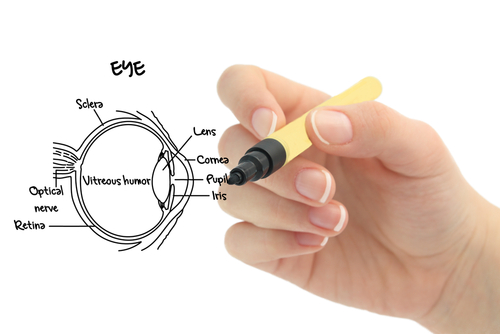
Did You Know That?
Eye problems can range from being mildly irritating to signaling a serious disease and even the inability to legally drive. Some of these problems may resolve on their own while some may be chronic. Your eyes can be susceptible to many of the following issues.
Many of these eye problems are preventable by simply educating yourself and receiving regular eye exams. If your eyes don’t look, feel or see well, please book an appointment with one of our experienced optometrists.
Glaucoma
Did you know that Glaucoma is optic nerve damage which may be associated with increased pressure in the eye?
Glaucoma can happen gradually or suddenly which is then considered a medical emergency. Raised intraocular pressure is a significant risk factor for developing glaucoma (above 22mmHg). One person may develop nerve damage at a relatively low pressure, while another person may have high eye pressure for years and yet never develop damage. Untreated glaucoma leads to permanent damage of the optic nerve and resultant visual field loss, which can progress to blindness. Glaucoma has been nicknamed the “sneak thief of sight” because the loss of visual field often occurs gradually over a long time and may only be recognized when it is already quite advanced. Once lost, this damaged visual field can never be recovered. Worldwide, it is the second leading cause of blindness. Glaucoma affects one in two hundred people aged fifty and younger, and one in ten over the age of eighty.
Diabetes
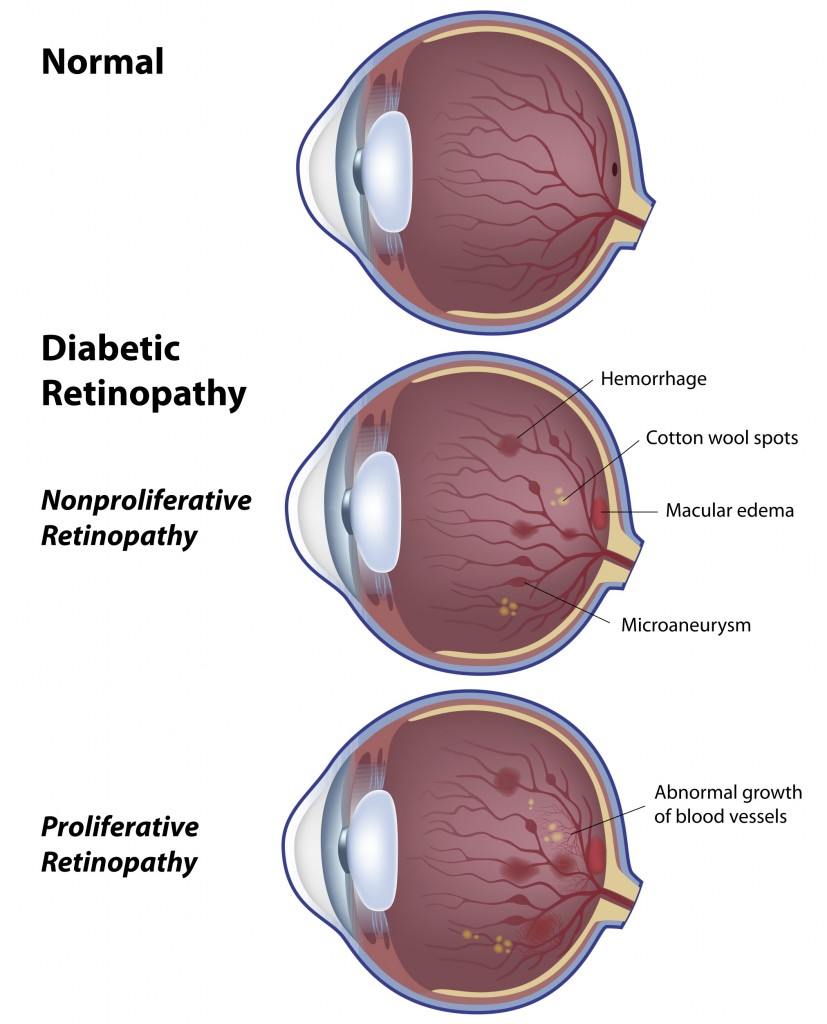 Did you know that Diabetic Retinopathy is the leading cause of blindness up to age 65?
Did you know that Diabetic Retinopathy is the leading cause of blindness up to age 65?
Early detection and treatment can prevent most diabetes-related blindness. Diabetic retinopathy is what happens when the retina undergoes changes due to chronic elevated levels or large fluctuation of blood sugar. Managing blood sugar levels can stabilize it, but without control, diabetic retinopathy can lead to blindness. It’s important to remember that the diagnosis of diabetes doesn’t cause the diabetic retinopathy, high blood sugar levels do. The recommendation is to have your A1C level at seven percent or less to minimize vision problems and have a dilated eye exam once a year. Patients with good eyesight and even 20/20 vision could still have a dangerous level of retinopathy. OHIP covers a yearly eye examination for diabetics and diabetic suspects.
(click picture to enlarge)
Cataracts
Did you know that Cataracts are a clouding that develops in the crystalline lens of the eye, varying in degree from slight to complete opacity?
The cloudiness over the eye’s lens will cause poor nighttime vision, halos around lights, and sensitivity to glare and daytime vision will be eventually affected. Cataracts typically progress slowly to cause vision loss and are potentially blinding if untreated. However, there is a very safe surgical procedure to remove the cloudy lens and replace it with an artificial lens.
Macular Degeneration
Did you know that Macular Degeneration is the leading cause of blindness after the age 65?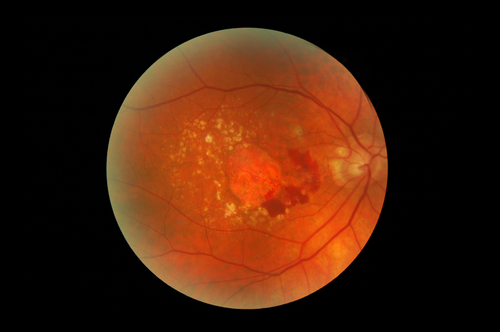
It is a medical condition which damages the retina and usually affects older adults, which results in a loss of, blurred or distorted vision (like seeing wavy lines). Colours may appear faded in the center of the visual field. It occurs in two forms in the retina. In the dry form, cellular debris called drusen accumulates between the retina and the choroid, and the retina can become detached. In the wet form, which is more severe, blood vessels grow up from the choroid behind the retina, and the retina can also become detached. It can be treated with laser coagulation, and with medication that stops and sometimes reverses the growth of blood vessels. Early detection is very important and with a daily dose of certain vitamins and antioxidants this debilitating disease can be slowed down.
Floaters
Did you know that Spots Floaters are tiny particles drifting across the eye and are usually very harmless?
However, they may be a sign of retinal detachment and you should never ignore any changes in your vision.
Retinal Detachment
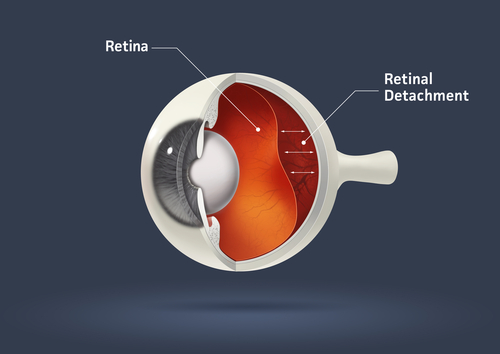 Did you know that Retinal Detachments can be repaired but time is of the essence?
Did you know that Retinal Detachments can be repaired but time is of the essence?
Symptoms include floaters and flashes of light across your visual field, or a sensation of a shade or curtain hanging on one side of your visual field. The onset of a Retinal Detachment is a true emergency.
Ophthalmic Migraine
Did you know that you can have an ophthalmic migraine without any pain or discomfort?
Your symptoms would be very similar to that of the start of a migraine headache, which include spots of light, halos, or zigzag patterns.
Near Sightedness
Did you know that the inability to see distant objects clearly is called Myopia?
It can cause difficulty driving, poor night vision, learning difficulties and headaches. People will often squint in an attempt to see well. Severe cases require a person with myopia to hold reading material at a very close distance in order to see.
Far Sightedness
Did you know that the inability to focus on near objects is called Hyperopia?
In severe cases it can also cause distance objects to appear blurry. It is frequently accompanied by headaches, reading difficulties and learning difficulties in children. To compensate, a person with farsightedness may have to hold objects at a further than normal reading distance.
Astigmatism
Did you know that Astigmatism can accompany nearsightedness or farsightedness? 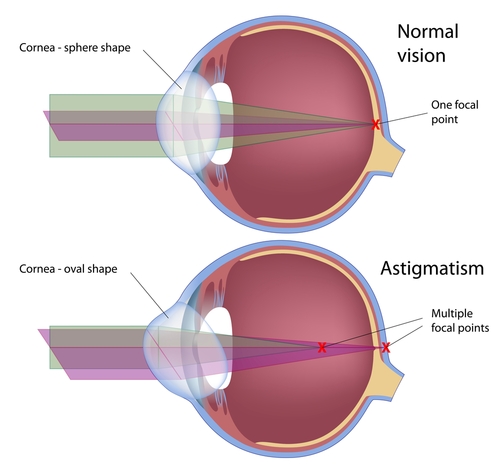
It is the result of an eye that is shaped like a football. It causes light to be focused at two points within the eye instead of one. The one place light should be focused in order to have clear vision is at the retina. Astigmatism can cause distorted vision at all distances, leading to headaches, eyestrain and squinting.
(click picture to enlarge)
Presbyopia
Did you know that the eyes lose their natural focusing ability with age?
It results in difficulty reading and often appears in a person’s forties. It also can lead to headaches and having to hold reading materials at a further than normal reading distance.
Amblyopia
Did you know that an eye that never reaches its full visual potential is called Amblyopia?
It can be caused by a turned eye (a.k.a. strabismus), cataracts in infancy, or due to unequal vision disorders, such as myopia or hyperopia in one eye that is much greater than in the fellow eye. People with amblyopia are at a greater risk to lose vision in the healthy eye due to below normal binocular vision. Having a lazy eye can limit a person’s choice of careers, such as restricting them for applying for positions in the police force. If detected early, a lazy eye can be treated and its effects can be reversed through visual training. Visual training has the best prognosis of visual recovery if started before the age of 7 years old. It is important for parents to know that a child cannot reliably report poor vision until the age of about 9, and therefore all children, even in the absence of vision complaints or symptoms, should have their vision tested at about the age of 6 months and then yearly from the age of 3.
Subconjunctival Hemorrhage
Did you know that these are common and are caused by broken blood vessels near the surface of the eye?
They can be caused by rubbing your eye, coughing, sneezing or from blood thinning medication. These usually look worse than they are but still need to be assessed by our optometrists.
